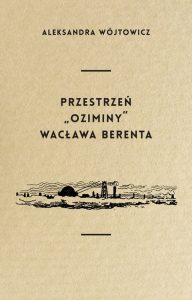Aleksandra Wójtowicz, Wacław Berent’s Snowy Crop’s space
Warsaw: Publisher ILR PAS (Wydawnictwo Instytutu Badań Literackich PAN), 2019

Reviewers: prof. dr hab. Maria Olszewska, dr hab. Hanna Ratuszna, prof. UMK
Cover desing: Magdalena Błażków
Editing: Magdalena Szczepańska
Index: Tomasz Ostromęcki
Proof-reading: Krystyna Kiszelewska-Kotyńska
Anter – Poligrafia
Printing: Print Group Sp. z o.o., Szczecin
A book Wacław Berent’s Snowy Crop’s space (Przestrzeń “Oziminy” Wacława Berenta) Aleksandra Wójtowicz advances her theses about a new outlook on the issue of space in Berent’s novel. Wójtowicz understands space in Ozimina in three different ways: 1) as the spatial context of the-then Warsaw, 2) as the space created in the novel, 3) as the composition space: she argues that this novel bears resemblance to the fugue and she describes the evolution of its text published in the different editions.
In her book Wójtowicz also recreates the spatial context of 1904–1910 Warsaw and analyses the symbols constructed by using the semantics of the actual fragments of Warsaw. She also proposes a new perspective — the ‘window perspective’ – as the third one aside the overground and the aerial ones. In Berent’s novel Wójtowicz also discerns elements of simultanism and the use of a literary device she calls ‘clarifying retrospective’. Finally, she also writes about the additional significance of the figure of the circle and its connection with Berent’s search for a community model.
Wójtowicz also argues that Berent’s Ozimina should be analysed as a literary fugue – a literary version of the musical genre of the fugue. She presents her point of view by illustrating how voices are conducted in a musical composition (here, Jan Sebastian Bach’s fugue) and then showing the ways in which voices are conducted in the novel. This also discusses the changes introduced by Berent during the preparation of his novel for printing (1910, 1924, and 1933 editions), illustrating the differences with excerpts and tables. Wójtowicz explains the modifications in the novel in terms of the change in the socio-political situation in which the author worked on the different editions of Ozimina.
One of the main methods of literary analysis used by Wójtowicz is geocriticism, defined by Bertrand Westphal. She also makes references to literary cartography, for instance, Franco Moretti’s works. The part of the dissertation devoted to Ozimina’s composition contains reference not only to Mikhail Bakhtin’s work, but also to newer works about interdisciplinary comparatistics and research on literature’s musicality.
The methodology of Wójtowicz’s research is based on a combination of traditional approaches and new propositions connected with the topographic turn and also combination of scientific editing combination with interpretation. The methodology of this dissertation is based on a term coined by Edward W. Soja – thirdspace, which plays two roles in this text, as Aleksandra Wójtowicz uses it not only to interpret Berent’s works, but also to plan the three-part composition of her book.